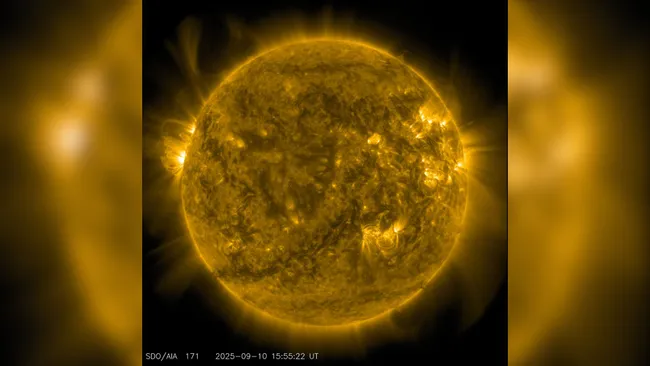The JWST Stellar Nursery Image has once again showcased the breathtaking capabilities of the James Webb Space Telescope (JWST). What appears to be a craggy, starlit mountaintop is in fact a massive stellar nursery, where infant stars are blasting away their dusty cocoons with powerful radiation and winds. This spectacular snapshot is not just a visual marvel—it is a scientific treasure trove that helps astronomers understand how stars form, evolve, and shape their environments.
Why Stellar Nurseries Matter
Stellar nurseries are vast regions of gas and dust where stars are born. These cosmic birthplaces are critical to understanding the lifecycle of galaxies, including our own Milky Way. By observing them, astronomers can answer key questions:
- How do stars ignite from cold clouds of gas?
- What role does turbulence play in star formation?
- How do massive stars influence the surrounding environment?
The JWST Stellar Nursery Image provides clarity on these questions by capturing fine details previously impossible to see with older telescopes like Hubble or Spitzer.
What the JWST Image Shows
The latest image shows towering columns of gas and dust illuminated by the energy of newborn stars. The scene is dramatic:
- Dusty Peaks: What looks like rocky mountains are actually dense gas structures.
- Starlight Glow: Massive, infant stars emit ultraviolet radiation, eroding their dusty surroundings.
- Dynamic Winds: Stellar winds carve intricate shapes into the clouds, pushing away material and triggering further star formation nearby.
This interplay of destruction and creation is what makes stellar nurseries so fascinating. Stars destroy the very clouds that birthed them, yet in doing so, they spark the next generation of stars.
Science Behind the JWST Stellar Nursery Image
The JWST Stellar Nursery Image was captured using JWST’s Near-Infrared Camera (NIRCam) and Mid-Infrared Instrument (MIRI). These tools can peer through thick dust clouds that block visible light, allowing astronomers to see the hidden stars inside.
Some highlights from the scientific findings:
- Protostars Identified: JWST can spot young stars still forming inside their gas cocoons.
- Feedback Mechanisms: The image shows how stellar winds and radiation shape entire regions.
- Dust Chemistry: Infrared data reveals the presence of organic molecules, silicates, and other dust components vital to planet formation.
Comparing JWST with Hubble
The Hubble Space Telescope provided iconic images of stellar nurseries, such as the Pillars of Creation in the Eagle Nebula. However, JWST takes this to the next level.
- Infrared Vision: JWST can see deeper into dust clouds, where Hubble’s view is blocked.
- Higher Resolution: Details are sharper, showing structures just a few hundred astronomical units across.
- Chemical Insights: JWST not only shows what’s there but also what it’s made of.
The JWST Stellar Nursery Image proves that Webb is not simply replacing Hubble, but extending humanity’s vision into entirely new realms.
Broader Implications of the Discovery
Beyond pure astronomy, the JWST Stellar Nursery Image has wider significance:
- Origins of Solar Systems: By observing nurseries, scientists can see the conditions under which planets like Earth may have formed.
- Galactic Evolution: Star formation drives the life cycle of galaxies. Nurseries like this reveal how galaxies evolve over billions of years.
- Astrobiology Links: Organic molecules detected in nurseries hint at the building blocks of life forming alongside stars.
In essence, this image helps connect the dots between cosmic dust and living planets.

The Role of Massive Stars
One of the striking aspects of the JWST Stellar Nursery Image is the dominance of massive, infant stars. These stars are rare but influential, shaping the galaxy with their energy:
- They carve cavities into the gas.
- Their radiation drives chemical reactions.
- When they die in supernovae, they enrich space with heavy elements like carbon, oxygen, and iron—essential for life.
Thus, stellar nurseries are not just places of birth but also factories for the ingredients of future planets and organisms.
Public Fascination with JWST
The release of the JWST Stellar Nursery Image has captured the public’s imagination worldwide. Social media lit up with comparisons to mountain ranges, fantasy landscapes, and works of art. Beyond aesthetics, it underscores humanity’s innate curiosity about the universe and our origins.
Looking Ahead: JWST’s Next Targets
JWST is just getting started. Its future observations will explore:
- More stellar nurseries in the Milky Way and beyond.
- Protoplanetary disks where planets are forming.
- Galaxies at the edge of the observable universe.
Each new image builds a deeper narrative of how cosmic structures evolve, and the JWST Stellar Nursery Image is one of the first chapters in that story.
Conclusion
The JWST Stellar Nursery Image is both a visual masterpiece and a scientific milestone. It reveals how infant stars sculpt their birthplaces, offers chemical insights into planet-forming dust, and deepens our understanding of galactic evolution.
For astronomers and the public alike, it’s a reminder that the cosmos is alive with activity, constantly renewing itself through cycles of creation and destruction. With JWST at the helm, we’re witnessing this process more clearly than ever before.


